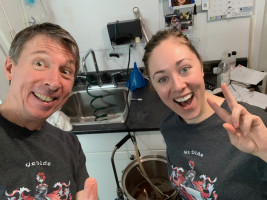Brew Log History
Ambient: {{ stats.ambient | number:0 }} °F
OG: {{ stats.ogGravity | number:3 }}
Attenuation: {{ stats.attenuation | number:2 }}%
Calories: {{ stats.calories | number:1 }} / 12oz
Carbs: {{ stats.carbs | number:1 }} g / 12oz
Readings: {{ readingsCount | number }}
{{ formatHeaderDate(dates.navStart) | date:'mediumDate' }} to {{ formatHeaderDate(dates.navEnd) | date:'mediumDate' }}
Last Updated: {{ stats.lastupdated.ago }} from {{ stats.lastupdated.source }}
Hops
|
Amount
|
Variety
|
Cost
|
Type
|
AA
|
Use
|
Time
|
IBU
|
Bill %
|
|
1 oz |
First Gold1 oz First Gold Hops |
|
Pellet |
7.5 |
Boil
|
30 min |
24.44 |
33.3% |
|
1 oz |
First Gold1 oz First Gold Hops |
|
Pellet |
7.5 |
Whirlpool
|
0 min |
5.62 |
33.3% |
|
1 oz |
First Gold1 oz First Gold Hops |
|
Pellet |
7.5 |
Dry Hop
|
0 days |
|
33.3% |
|
3 oz
/ $ 0.00
|
Hops Summary
|
Amount
|
Variety
|
Cost
|
IBU
|
Bill %
|
|
3 oz |
First Gold (Pellet) 2.9999999931377 oz First Gold (Pellet) Hops |
|
30.06 |
99.9% |
|
3 oz
/ $ 0.00
|
Mash Guidelines
|
Amount
|
Description
|
Type
|
Start Temp
|
Target Temp
|
Time
|
|
|
|
|
-- |
152 °F |
90 min |
Starting Mash Thickness:
2 qt/lb
|
Priming
|
Method: dextrose
Amount: 4.1 oz
Temp: 68 °F
CO2 Level: 2.25 Volumes |
Target Water Profile
Colpoys
Notes
Recipe calls for London Ale III but I'll be using dry yeast so S-05.
Ferment at 65F for the first week, then allow to free rise to 68-70F.
Cold crash then add dry hops.
Carbonate to 2.25 vol CO2.
Full Article below and in URL
This light, bright ale may become one of your springtime favorites after a few renditions, and columnist Josh Weikert says he'd take it over most any of the soon-to-hit-the-shelves Spring or Summer Ales found stateside.
JOSH WEIKERT 2 years ago
Make Your Best: British Golden Ale Primary Image
Question: If I were to take an American Pale Ale or Session IPA and instead make it with English ingredients, what beer style would I have?
Answer: Not an English Pale Ale. Or an English IPA.
English Pale Ale - insofar as we use the name at all - is more properly associated with English Bitters. No one, though, would ever mistake an English Pale Ale for an American Pale Ale. No, if we want something that falls more in line with what we think of as an American Pale Ale but with that taste of Britain, then we're actually better off looking to the British Golden Ale instead! This light, bright ale may become one of your springtime favorites after a few renditions, and speaking for myself I'll take it over most any of the soon-to-hit-the-shelves Spring or Summer Ales found stateside.
STYLE
For a start it's…well, pale, which the English Bitter isn't. Really pale. Referring to it as a "Golden Ale" is being pretty generous, actually, as its color range is roughly the same as what you find in American Premium Lager. Far less malt-oriented than traditional Bitters, this style features only a moderate amount of bread or biscuit malt flavor to balance a surprising amount of bitterness. Hops aren't only for bittering, though - you should feel free to swing for the fences in terms of hops flavor and aroma as well. The foundation of this recipe of mine is actually a session IPA, amended for regional authenticity. It's very hoppy. And, like other session-strength beers, it's very light in alcohol: 4.2 percent ABV, in this case. The guidelines will also tell you that this style was originally brewed with English hops, but that more-recent versions are prone to using American citrus-flavored hops. Luckily, a homebrewer-friendly hops market now makes it possible to source UK hops that fit the bill, though the more tropical-fruit-loving among you are more than welcome to swap in your favorite New World varieties!
ADVERTISEMENT
Ultimately, this is a light, refreshing, hops-forward English ale that you will never confuse with your favorite ESB.
RECIPE
I can't tell you how strange it was to brew an English style without my go-to British crystal malts, but this is a pretty simple grist that doesn't require them. We start with three pounds of Maris Otter and four pounds of standard 2-row pale malt. To that we add one pound of white wheat malt. That's all she wrote: it gives us a pleasantly pale SRM of 4 and a bit of grainy, doughy maltiness, which is all we want. It also lacks (as noted) any crystal malts or unfermentable sugars, but as we're looking for a light-bodied beer, that's par for the course.
We'll be using one of two hops: First Gold if you can find it, Pilgrim if you can't; if neither of those is available, then Target is reasonable as a last resort (or default to your favorite American hops and try again another time). The reason I like those two hops is that they both have a great orange marmalade aroma that feels very authentically English (and both are English hops) along with some other fun fruity flavors. They're also both reasonably high in alpha acids, so you won't need a ton. Add 35 IBUs of your chosen hops in a 30-minute addition, then one more ounce at flameout or in the whirlpool, and hold onto another 0.5-1 ounce for dry hopping.
London Ale III makes a good choice for your yeast here.
PROCESS
Mash at 152F for 90 minutes to increase wort fermentability, then lauter/sparge and boil as usual. Chill and pitch, but if you usually run pure oxygen into the headspace, don't: we want the yeast to struggle just a bit so that they produce some fruity esters to complement the hops. Ferment at 65F for the first week, then allow to free-rise. Unlike in the English Bitter we don't want any diacetyl here, so if your beer doesn't reach 68-70F on its own, put it in a warm room to finish fermenting and do a proper diacetyl cleanup. Cold crash to clear (though London III already does a great job on its own of flocculating out!), then add your dry hops. If you can only get a small amount of our preferred First Gold or Pilgrim, I'd recommend reserving it for use here: the aromatics are almost like a good fruit tea, and play out well as a dry hop. The guidelines won't mention it, but…you can get away with it. It improves the impression of this as a light, hoppy beer, and in competition it's unlikely you'll run across a judge that has had enough of this style to know it's atypical! And dry hops aren't specifically prohibited… Carbonate to 2.25 volumes of CO2 (enough to differentiate it clearly from cask bitters, but not high enough to create a harsh carbonic bite), and enjoy!
IN CLOSING
I'm almost positive you'll find that this hopping regime is enough to get a comprehensive bitterness, flavor, and aroma experience, but you may need to throttle the additions differently depending on the particular hops you're using. Don't be shy with them: this is a decidedly hoppy and bitter beer. Show just a hint of restraint, though: too heavy a hand with the hops and you might make a beer that's indistinguishable from an American session IPA! Cheers.

Last Updated and Sharing

- Public: Yup, Shared
- Last Updated: 2020-03-31 11:29 UTC
For quick copying and pasting to a text based forum or email.
Click the Download as HTML file button below.
Recipe costs can be adjusted by changing the batch size. They won't be saved but will give you an idea of costs if your final yield was different.
|
Cost $ |
Cost % |
| Fermentables |
$ |
|
Steeping Grains
(Extract Only) |
$ |
|
| Hops |
$ |
|
| Yeast |
$ |
|
| Other |
$ |
|
| Cost Per Barrel |
$ 0.00 |
|
| Cost Per Pint |
$ 0.00 |
|
| Total Cost |
$ 0.00 |
|
Discussion about this recipe:





